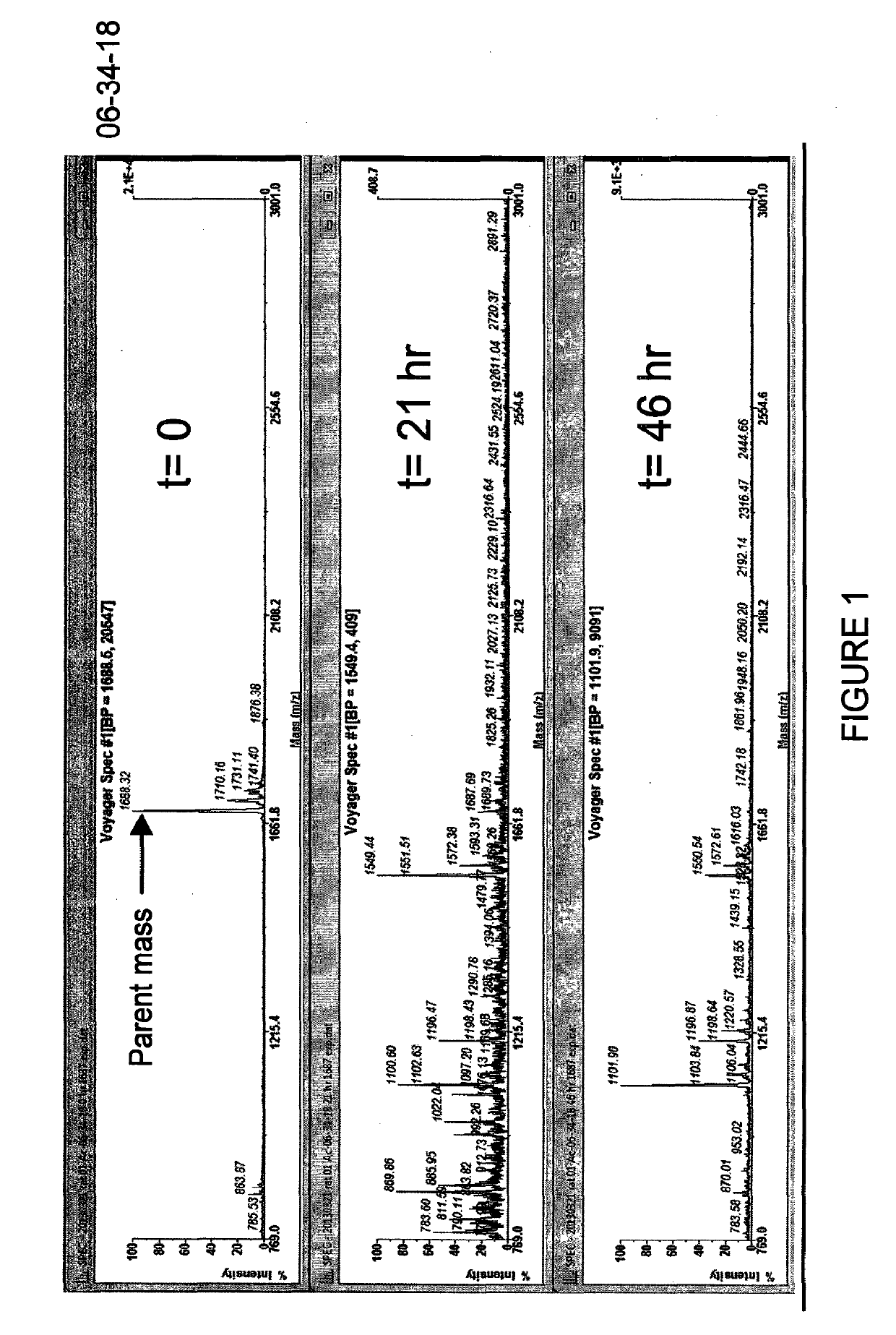Polypeptide ligands specific for plasma kallikrein
a polypeptide and plasma kallikrein technology, applied in the field of polypeptides, can solve the problems of reducing the conformational flexibility of the cyclic structure, and achieve the effects of enhancing the ability to formulate bicyclic peptide leads, good cross-reactivity, and high metabolic stability in vivo
- Summary
- Abstract
- Description
- Claims
- Application Information
AI Technical Summary
Benefits of technology
Problems solved by technology
Method used
Image
Examples
example 1
ation of Kallikrein-Binding Bicyclic Peptides with Favourable Homologue Selectivity and Species Cross-Reactivity
(a) Identification of Novel, Potent, Human and Rat Cross-Reactive Lead Sequences
[0168]For any given therapeutic bicyclic peptide, its pharmacodynamic and pharmacokinetic properties need to be evaluated in preclinical animal species. Common preclinical species include rat, mouse, rabbit, dog, minipig and cynomolgus.
[0169]Due to the generally high selectivity of bicyclic peptides, which in part is facilitated by their large contact area to the target protein, high affinity bicyclic peptides to a human target protein may not cross-react with the same target protein derived from a given preclinical species, making preclinical evaluation of such a lead difficult. An example includes PK15 (as disclosed in WO 2009 / 098450), which is a potent bicyclic peptide (6×6 loop size) with a Ki of ˜1.2 nM to human kallikrein. Potency to rat kallikrein is markedly decreased, at a Ki of ˜500 n...
example 2
ability Screen of Kallikrein-Binding Bicyclic Peptides Reveals Promising Lead Candidates
[0189]In Example 1, several novel bicyclic lead sequences were identified with high human and rat potencies. The most potent member of each family was selected for comparison of rat and human plasma stabilities. These were 06-254-02, 06-255, 06-259-02 and 06-261. Initial screening using Method #1 indicated 06-255 and 06-259-02 to be more stable than the remaining bicyclic peptides, as judged by a longer window of detection of these two peptides (up to 10 days, figures not shown). The remaining peptides were no more detectable after 2-3 days, displaying a similar low stability as the unmodified sequence of 06-34-18.
[0190]06-255 and 06-259-02 both suffered from a poor solubility profile, and were thus resynthesised with a solubilising C-terminal extension (Sar3-(D-Arg)2 (SEQ ID NO: 98)). Sarcosine3 (Sar3) hereby serves as a molecular spacer, while the D-arginines impart higher aqueous solubility to...
example 3
Peptide Loops Between Different Bicyclic Peptide Leads Generates Novel Chimeric Constructs with Favourable Properties
[0193]The first loop of the previously disclosed 06-34-18 sequence (WO 2013 / 050616, sequence: SWPARLHQDL (SEQ ID NO: 86)) shares a similar FPFR motif (SEQ ID NO: 100, underlined) with the 06-261 peptide identified herein (sequence: NNFPFRVYYPDI (SEQ ID NO: 54)). However, 06-34-18 is described to contain two proteolytic recognition sites that render the peptide labile towards blood plasma proteases and therefore unsuitable as a kallikrein inhibiting therapeutic. These sites comprise residues Arg5 and His7 of 06-34-18 (SWPALQDL (SEQ ID NO: 86): underlined and bold). In the presently disclosed 06-261 sequence (Example 1), the equivalent histidine proteolytic recognition site in loop 2 is absent.
[0194]Due to the lack of His7 in the second loop of 06-261 (sequence: VYYPDI (SEQ ID NO: 87)), the inventors of the present invention replaced the proteolytically labile, histidin...
PUM
 Login to View More
Login to View More Abstract
Description
Claims
Application Information
 Login to View More
Login to View More - R&D
- Intellectual Property
- Life Sciences
- Materials
- Tech Scout
- Unparalleled Data Quality
- Higher Quality Content
- 60% Fewer Hallucinations
Browse by: Latest US Patents, China's latest patents, Technical Efficacy Thesaurus, Application Domain, Technology Topic, Popular Technical Reports.
© 2025 PatSnap. All rights reserved.Legal|Privacy policy|Modern Slavery Act Transparency Statement|Sitemap|About US| Contact US: help@patsnap.com



